Sushi is a popular Japanese dish that has gained popularity worldwide. It is a dish that consists of vinegared rice, raw or cooked seafood, vegetables, and other ingredients. Sushi rolls, also known as makizushi, are a favorite among sushi lovers. But have you ever wondered about the nutritional content of your favorite sushi roll? In this article, we will explore the number of calories in a sushi roll and other important nutritional information.
Sushi rolls come in various types and sizes, and the nutritional content can vary greatly depending on the ingredients used. Some sushi rolls are low in calories and fat, while others can be high in both. It is essential to understand the nutritional content of sushi rolls to make informed choices about your diet. We will discuss the nutritional content of sushi rolls, including calories, protein, carbs, fat, and sodium, and explore healthy sushi choices and high-calorie ingredients to watch out for.
Key Takeaways
- Sushi rolls are a popular Japanese dish that consists of vinegared rice, raw or cooked seafood, vegetables, and other ingredients.
- The nutritional content of sushi rolls can vary greatly depending on the ingredients used, making it essential to understand the nutritional information to make informed choices about your diet.
- Understanding healthy sushi choices and high-calorie ingredients to watch out for can help you enjoy sushi rolls without compromising your health.
What is Sushi
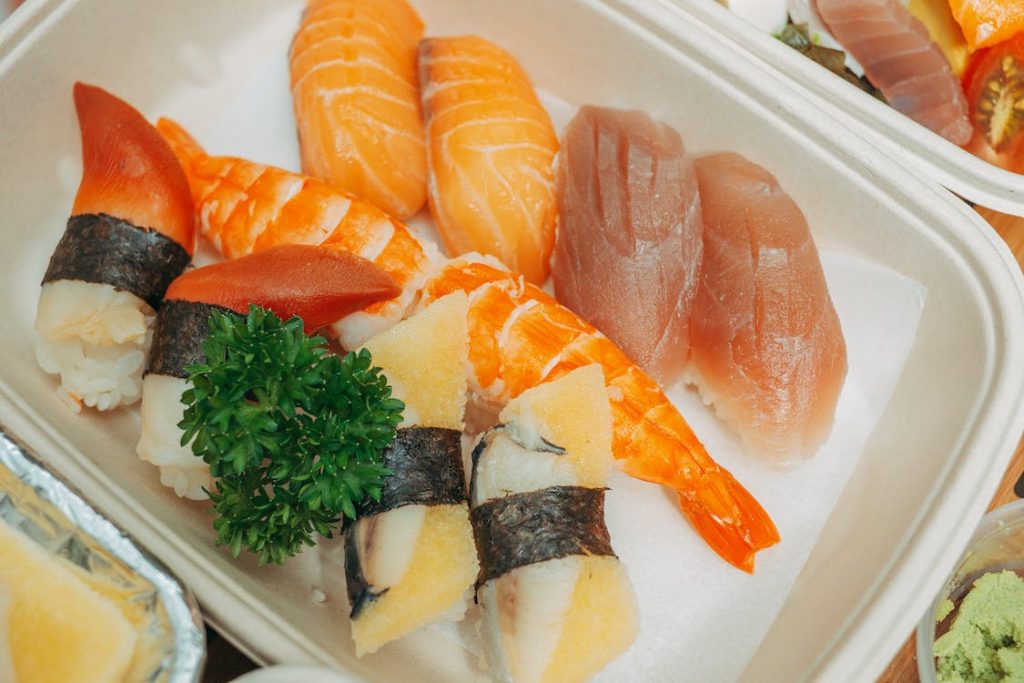
Sushi is a Japanese dish that consists of vinegared rice combined with various ingredients such as raw fish, vegetables, and seaweed. The dish is often served with soy sauce, pickled ginger, and wasabi.
There are several types of sushi, including nigiri sushi, maki rolls, and sushi pieces. Nigiri sushi is a type of sushi that consists of a small ball of rice topped with a slice of raw fish or other ingredients. Maki rolls, also known as sushi rolls, are made by wrapping sushi ingredients in seaweed and rice, and then cutting the roll into bite-sized pieces. Sushi pieces are simply pieces of sushi that are served individually.
The ingredients used in sushi can vary widely, depending on the type of sushi and the region in which it is prepared. Raw fish is a common ingredient in many types of sushi, but cooked fish, vegetables, and other ingredients can also be used. Seaweed is often used to wrap sushi rolls and adds a distinct flavor to the dish.
When it comes to sushi rolls, the calorie count can vary widely depending on the ingredients used. Maki rolls with fish, vegetables, and without extra sauces tend to have a lower calorie count, while rolls with fried tempura batter or lots of extra fillings and sauces tend to have a higher calorie count. A typical 6-piece sushi roll contains between 200-250 calories.
Overall, sushi is a delicious and healthy dish that can be enjoyed in a variety of ways. Whether you prefer nigiri sushi, maki rolls, or sushi pieces, there is sure to be a sushi dish that suits your tastes.
Types of Sushi Rolls
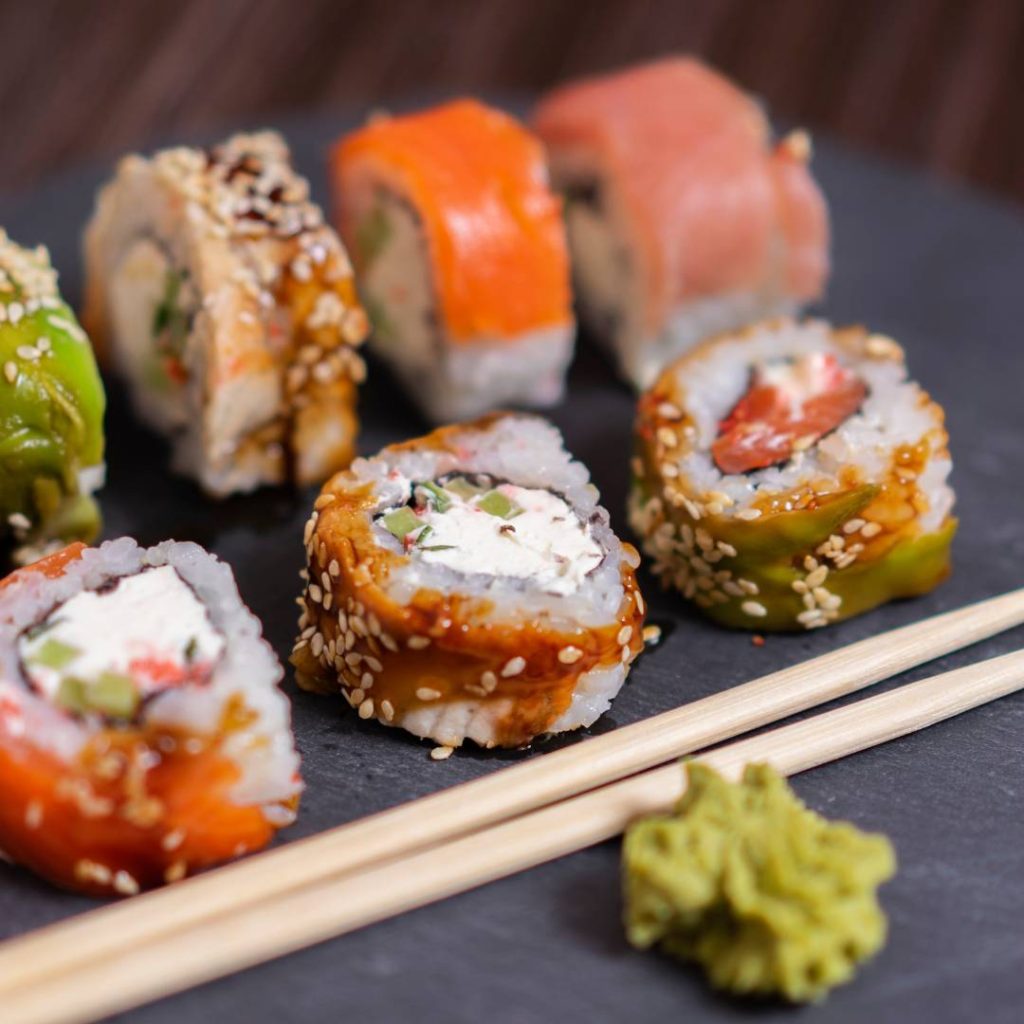
Sushi rolls come in a variety of flavors and ingredients, making it a versatile dish that can cater to anyone’s taste buds. Here are some of the most popular types of sushi rolls:
- California Roll: This is a classic sushi roll that is perfect for beginners. It typically contains imitation crab meat, avocado, and cucumber. The roll is then wrapped in seaweed and rice.
- Tempura Roll: This is a deep-fried sushi roll that is crispy on the outside and soft on the inside. It usually contains shrimp tempura, avocado, and cucumber. This roll is higher in calories due to the deep-frying process.
- Spicy Tuna Roll: This roll is perfect for those who love a little bit of heat. It typically contains raw tuna, spicy mayo, and cucumber. The spicy mayo adds a creamy texture to the roll.
- Shrimp Tempura Roll: This roll is similar to the tempura roll but contains shrimp tempura instead of vegetables. It’s a great option for those who love seafood.
- Rainbow Roll: This roll is perfect for those who love a variety of fish. It typically contains crab, avocado, and cucumber. The roll is then topped with a variety of fish such as tuna, salmon, and yellowtail.
- Spider Roll: This roll contains soft-shell crab, avocado, and cucumber. It’s a great option for those who love seafood and want to try something different.
- Philadelphia Roll: This roll is perfect for those who love cream cheese. It typically contains smoked salmon, cream cheese, and cucumber.
- Tuna Roll: This roll is perfect for those who love raw tuna. It typically contains raw tuna and cucumber.
- Avocado Roll: This roll is perfect for vegetarians and vegans. It typically contains avocado and cucumber.
- Salmon Roll: This roll is perfect for those who love raw salmon. It typically contains raw salmon and cucumber.
- Dragon Roll: This roll is perfect for those who love eels. It typically contains eel, avocado, and cucumber. The roll is then topped with avocado slices to resemble dragon scales.
- Eel Avocado Roll: This roll is perfect for those who love eel and avocado. It typically contains eel and avocado.
- Caterpillar Roll: This roll is similar to the dragon roll but contains eel instead of crab. It’s a great option for those who love eels.
- Shrimp Roll: This roll is perfect for those who love shrimp. It typically contains cooked shrimp and cucumber.
- Veggie Roll: This roll is perfect for vegetarians and vegans. It typically contains a variety of vegetables such as cucumber, avocado, and carrot.
- Spicy Salmon Roll: This roll is similar to the spicy tuna roll but contains salmon instead of tuna. It’s a great option for those who love salmon.
- Tuna Maki: This is a classic sushi roll that is perfect for those who love raw tuna. It typically contains raw tuna and rice.
- Sushi Chefs: Sushi chefs are the experts who create these delicious sushi rolls. They have years of experience and use only the freshest ingredients to create the perfect roll.
Nutritional Content of Sushi
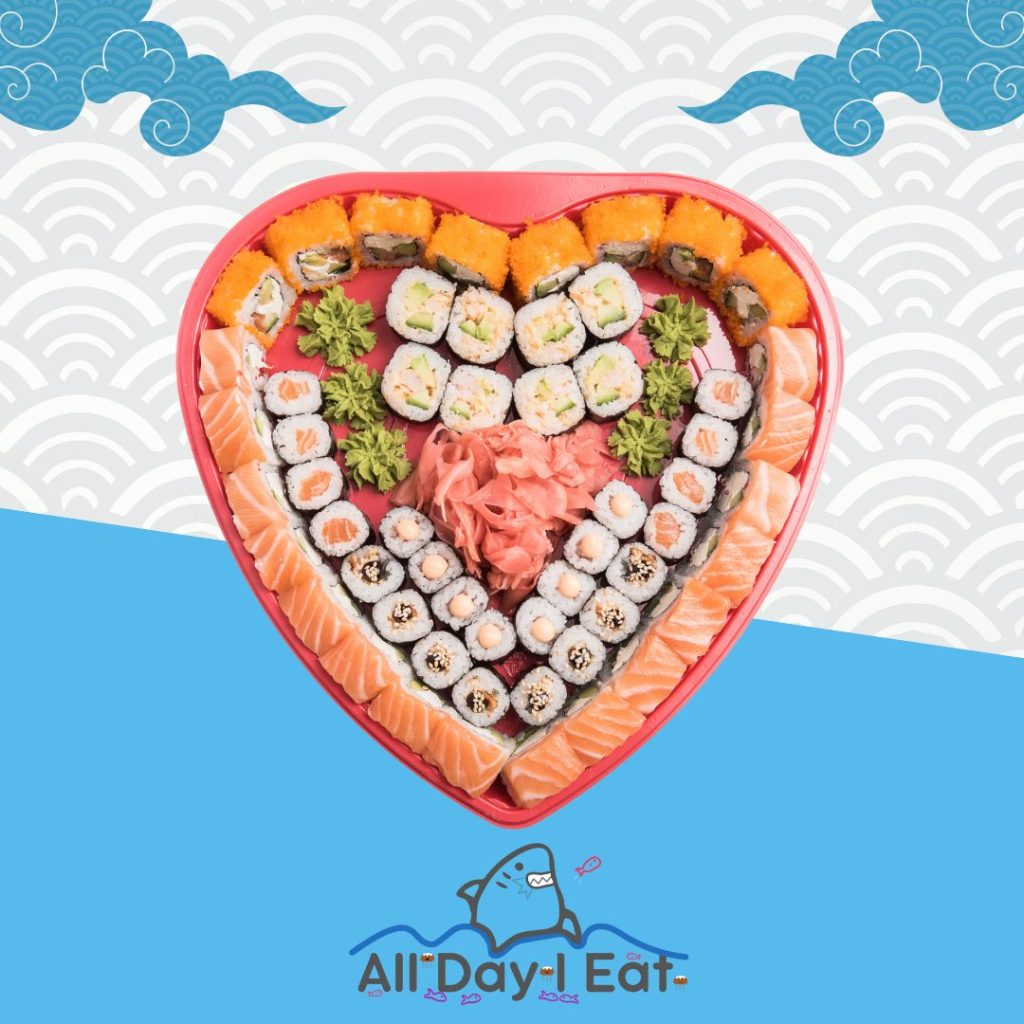
Sushi is a popular Japanese dish that is made with vinegared rice, seafood, vegetables, and sometimes fruits. Sushi rolls come in different sizes and varieties, making it difficult to give a specific calorie count. However, we can estimate the nutritional content of sushi rolls by considering the ingredients used.
Calories in a Sushi Roll
The number of calories in a sushi roll depends on the ingredients used. Rolls that contain fish or seafood are generally higher in protein and lower in calories than rolls that contain cream cheese or fried ingredients. For example, a typical California roll contains around 255 calories, while a spicy tuna roll contains around 290 calories.
In terms of macronutrients, sushi rolls are typically low in fat and high in carbs. The carbs in sushi come from the rice used, which is high in starch. Rolls that contain vegetables are also high in fiber, which can help keep you feeling full for longer.
Sodium and Cholesterol
Sushi rolls can be high in sodium, especially if they contain soy sauce or other salty condiments. Soy sauce is a common dipping sauce for sushi and can add up to 900 milligrams of sodium per tablespoon. Rolls that contain seafood are also naturally high in sodium. For example, a salmon roll contains around 300 milligrams of sodium.
Sushi rolls are generally low in cholesterol, as they do not contain any animal products except for seafood. Rolls that contain avocado or cream cheese may be higher in saturated fat, which can contribute to high cholesterol levels.
Vitamins and Minerals
Sushi rolls can be a good source of vitamins and minerals, especially if they contain vegetables or seafood. Rolls that contain seaweed are particularly high in iodine, which is important for thyroid function. Rolls that contain salmon or tuna are also high in omega-3 fatty acids, which are important for heart health.
Overall, sushi rolls can be a healthy and nutritious meal option, especially if you choose rolls that contain seafood and vegetables. However, it is important to be mindful of the calorie and sodium content, especially if you are watching your weight or have high blood pressure.
Healthy Sushi Choices
Sushi can be a healthy choice if you make the right choices. Here are some healthy sushi choices that you can consider:
Sashimi
Sashimi is thinly sliced raw fish that is served without rice. It is a great option for those who are looking for a low-carb and low-calorie meal. Some of the most popular types of sashimi include salmon, tuna, squid, octopus, and flounder. Sashimi is a simple, nutrient-dense sushi menu item that is high in protein and healthy fats. It is also low in calories and carbs, making it a great option for those who are watching their calorie intake.
Kappa Maki
Kappa Maki is a type of vegetarian sushi that is made with cucumber. It is a low-calorie and low-fat option that is perfect for those who are looking for a healthy sushi choice. Cucumber is rich in vitamins and minerals, and it is also a good source of antioxidants. Kappa Maki is also a good source of fiber, which can help you feel full for longer.
Vegetable Sushi
Vegetable sushi is another great option for those who are looking for a healthy sushi choice. Vegetable sushi is made with a variety of vegetables, such as avocado, cucumber, carrot, and bell pepper. Vegetables are rich in vitamins and minerals, and they are also a good source of fiber. Vegetable sushi is also low in calories and fat, making it a great option for those who are watching their calorie intake.
Edamame
Edamame is a popular Japanese snack that is made from steamed soybeans. It is a great source of protein, fiber, and healthy fats. Edamame is also low in calories and carbs, making it a great option for those who are looking for a healthy snack. You can enjoy edamame as a side dish or as a topping for your sushi.
Seafood
Seafood is a great source of lean protein and healthy fats. Some of the best seafood options for sushi include salmon, tuna, and shrimp. These seafood options are rich in omega-3 fatty acids, which can help to reduce inflammation and improve heart health.
In summary, sushi can be a healthy choice if you make the right choices. Some healthy sushi choices include sashimi, kappa maki, vegetable sushi, edamame, and seafood. These options are low in calories, high in nutrients, and can help you to maintain a healthy diet.
High-Calorie Ingredients in Sushi
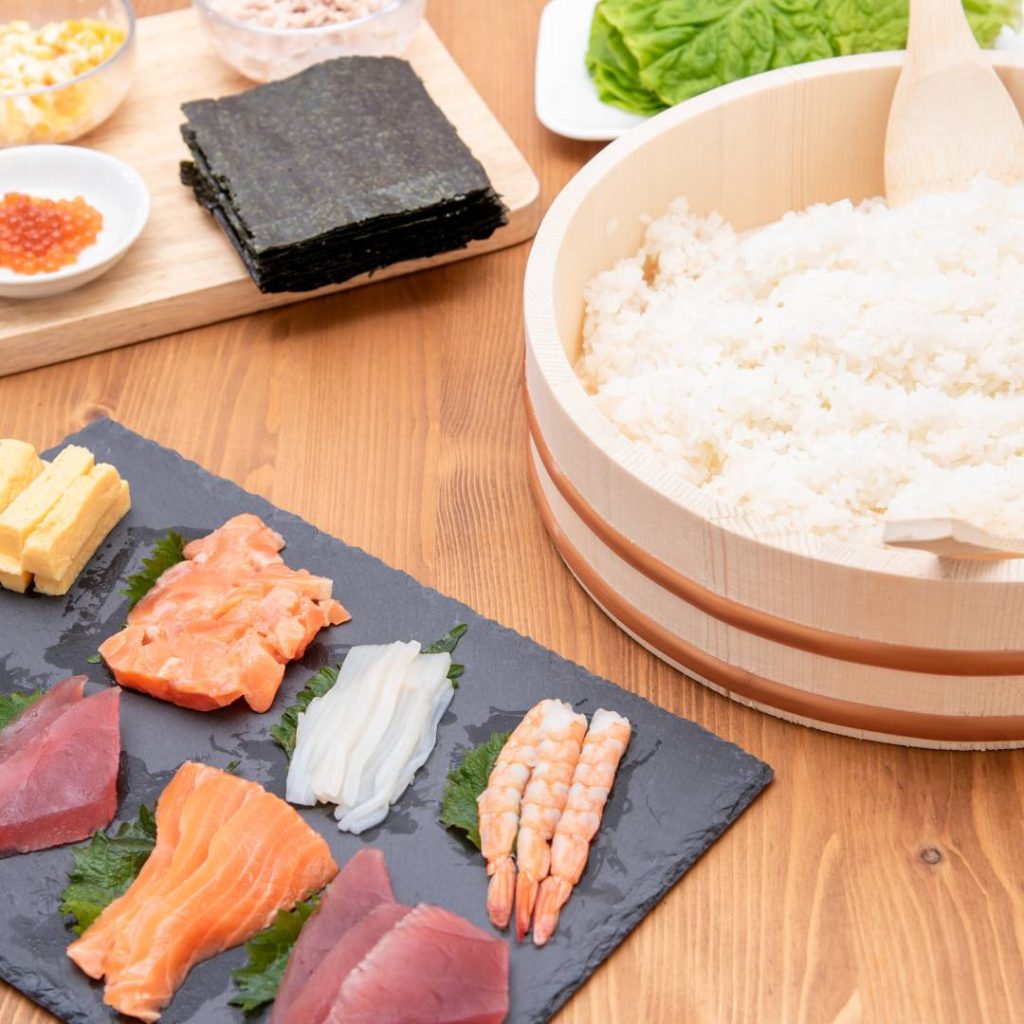
Sushi is a popular and delicious dish that can be enjoyed in many different forms. However, there can be high calories in a sushi roll due to the ingredients used. In this section, we will discuss some of the high-calorie ingredients that are commonly found in sushi rolls.
Tempura
Tempura is a Japanese dish that consists of battered and deep-fried seafood or vegetables. When used in sushi rolls, tempura can add a significant amount of calories. For example, a shrimp tempura roll can contain up to 500 calories, while a vegetable tempura roll can contain up to 400 calories. If you are trying to watch your calorie intake, it may be best to avoid sushi rolls that contain tempura.
Sauces
Sauces are often used to add flavor to sushi rolls, but they can also add a lot of calories. Some popular sushi sauces include eel sauce, spicy mayo, and soy sauce. Eel sauce is made from sugar, soy sauce, and mirin, and can add up to 60 calories per tablespoon. Spicy mayo is made from mayonnaise and chili sauce and can add up to 100 calories per tablespoon. Soy sauce is relatively low in calories, but it is high in sodium, which can contribute to water retention and bloating.
Cream Cheese
Cream cheese is a popular ingredient in many sushi rolls, but it can also add a lot of calories. A salmon avocado roll with cream cheese can contain up to 500 calories, while a Philadelphia roll (salmon and cream cheese) can contain up to 300 calories. If you are trying to watch your calorie intake, it may be best to avoid sushi rolls that contain cream cheese.
Smoked Salmon
Smoked salmon is a delicious ingredient that is often used in sushi rolls. However, it can also be high in calories. A smoked salmon roll can contain up to 300 calories, while a salmon avocado roll can contain up to 350 calories. If you are trying to watch your calorie intake, it may be best to limit your consumption of smoked salmon sushi rolls.
Hidden Calories
Finally, it is important to be aware of the hidden calories in a sushi roll. For example, some sushi rolls may contain crunchy toppings, which are often made from fried noodles or panko breadcrumbs. These crunchy toppings can add a significant amount of calories in a sushi roll. Additionally, some sushi rolls may contain hidden ingredients like sugar or mayonnaise, which can also add to the calorie count.
In conclusion, sushi rolls can be a healthy and delicious meal option, but it is important to be aware of the high-calorie ingredients that are commonly used. By avoiding sushi rolls that contain tempura, cream cheese, and excessive amounts of sauce, you can enjoy sushi while still maintaining a healthy diet.
Dietary Considerations
Sushi is a great option for those who are looking for a healthy meal. It is low in calories and fat, and it is packed with protein and essential nutrients. However, there are some dietary considerations to keep in mind when it comes to sushi.
Diet
Sushi is a great option for those who are on a diet. It is low in calories and fat, and it is packed with protein and essential nutrients. However, it is important to keep in mind that some sushi rolls can be high in calories and fat, especially those that are made with fried tempura batter or that contain lots of extra fillings and sauces. To keep your sushi meal healthy, stick to rolls that are made with fish, and vegetables, and without extra sauces. The avocado roll is a great option, as it is low in calories and fat.
Vegetarian and Vegan
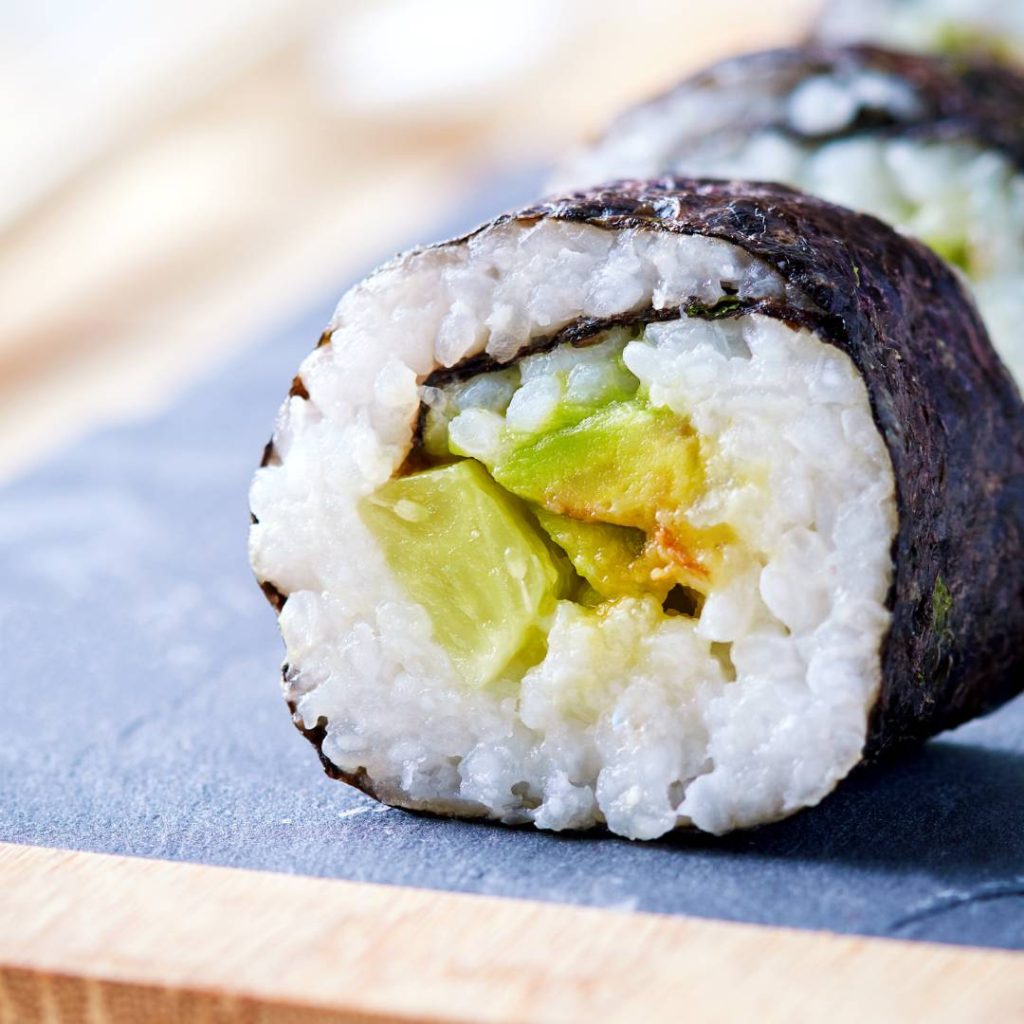
Vegetarians and vegans can enjoy sushi as well. There are plenty of vegetarian and vegan options available, such as cucumber rolls, avocado rolls, and vegetable rolls. Just make sure to ask your server about the ingredients to ensure that there are no animal products used in the sushi.
Weight Loss
Sushi can be a great option for those who are looking to lose weight. It is low in calories and fat, and it is packed with protein and essential nutrients. However, it is important to keep in mind that some sushi rolls can be high in calories and fat, especially those that are made with fried tempura batter or that contain lots of extra fillings and sauces. To keep your sushi meal healthy and low in calories, stick to rolls that are made with fish, and vegetables, and without extra sauces.
Walking
If you are looking to burn off some calories after a sushi meal, consider taking a walk. Walking is a great way to burn off calories and improve your overall health. Aim to walk for at least 30 minutes after your meal to help aid in digestion and burn off some of the calories consumed.
Recipes
If you are looking to make sushi at home, there are plenty of recipes available online. Just make sure to use fresh ingredients and to follow the recipe carefully to ensure that your sushi turns out delicious and healthy.
Potential Health Risks

Sushi is delicious and popular food, but it’s important to be aware of the potential health risks associated with consuming it. Some of the key risks include:
Mercury
Certain types of fish commonly used in sushi, such as tuna and swordfish, can contain high levels of mercury. Mercury is a toxic substance that can cause serious health problems if consumed in large quantities. Pregnant women, nursing mothers, and young children are particularly vulnerable to the harmful effects of mercury, so it’s important to be cautious when consuming sushi.
Raw Fish
Many types of sushi contain raw fish, which can carry harmful bacteria and parasites. This can lead to foodborne illnesses such as salmonella and E. coli. It’s important to make sure that the sushi you consume is prepared hygienically and that the fish is fresh and of high quality.
Saturated Fat and Cholesterol
Some types of sushi, such as those containing cream cheese or mayonnaise, can be high in saturated fat and cholesterol. Consuming too much of these can increase your risk of heart disease and other health problems. It’s important to choose sushi options that are low in saturated fat and cholesterol, such as those containing vegetables or lean proteins like tuna or salmon.
Sodium
Many types of sushi contain high levels of sodium, which can contribute to high blood pressure and other health problems. It’s important to be aware of your sodium intake and to choose sushi options that are lower in sodium. For example, you can opt for sushi rolls that contain vegetables or lean proteins instead of those that are fried or contain high-sodium sauces.
In summary, while sushi can be a healthy and delicious food choice, it’s important to be aware of the potential health risks associated with consuming it. By choosing high-quality, fresh sushi options and being mindful of your sodium, saturated fat, and cholesterol intake, you can enjoy sushi as part of a healthy and balanced diet.
Condiments and Their Impact

Sushi rolls are often served with a variety of condiments that can enhance the flavor of the dish. However, these condiments can also add calories and sodium to your meal. Here’s a breakdown of some common condiments and their impact on the nutritional value of your sushi roll:
Soy Sauce
Soy sauce is a staple condiment for sushi and is often used as a dipping sauce. While soy sauce is low in calories, it is high in sodium. One tablespoon of soy sauce contains around 900mg of sodium, which is about 39% of the recommended daily intake. To reduce your sodium intake, try using low-sodium soy sauce or using less soy sauce overall.
Pickled Ginger
Pickled ginger, or gari, is often served alongside sushi rolls to cleanse the palate between bites. While pickled ginger is low in calories and fat, it is high in sugar. One serving of pickled ginger contains around 1.5g of sugar, which can add up if you eat a lot of it. Keep in mind that pickled ginger is also often dyed pink with food coloring, which is unnecessary and adds no nutritional value.
Wasabi
Wasabi is a spicy condiment that is often served with sushi rolls. While wasabi is low in calories, it can be high in sodium if you use too much. Additionally, many sushi restaurants serve a mixture of wasabi and horseradish, which can increase the spiciness and make it harder to control how much you use. To avoid consuming too much sodium, try using wasabi sparingly or asking for it on the side.
Other Condiments
Other condiments that are sometimes served with sushi rolls include mayonnaise, eel sauce, and spicy mayo. These condiments are high in calories, fat, and sugar, and should be used sparingly or avoided altogether if you are watching your calorie intake. If you are unsure about the nutritional value of a particular condiment, ask your server or look it up online before ordering.
Overall, while condiments can add flavor to your sushi roll, they can also add unwanted calories and sodium. To keep your sushi roll as healthy as possible, try using condiments sparingly or opting for low-sodium options when available.
Understanding Food Labels
Reading food labels can be confusing, but it is an important step in making informed decisions about what you eat. Understanding the information on food labels can help you manage your calorie intake and make healthier choices.
Serving Size
The serving size on a food label is the amount of food that is typically eaten at one time. It is important to pay attention to the serving size because the calorie and nutrient information on the label is based on that serving size. If you eat more than the serving size, you will be consuming more calories and nutrients than what is listed on the label.
Calories
The calorie information on a food label tells you how much energy you will get from one serving of that food. It is important to pay attention to the calorie information because consuming too many calories can lead to weight gain and other health problems. The daily calorie intake recommendation varies from person to person and depends on factors such as age, gender, height, weight, and activity level.
Nutrients
Food labels provide information about the nutrients in the food, including fat, cholesterol, sodium, carbohydrates, fiber, sugar, and protein. It is important to pay attention to the amounts of these nutrients because consuming too much or too little of them can affect your health. The daily value (DV) percentage listed on the label helps you understand how much of each nutrient is in one serving of the food and how it fits into your daily diet.
Daily Value
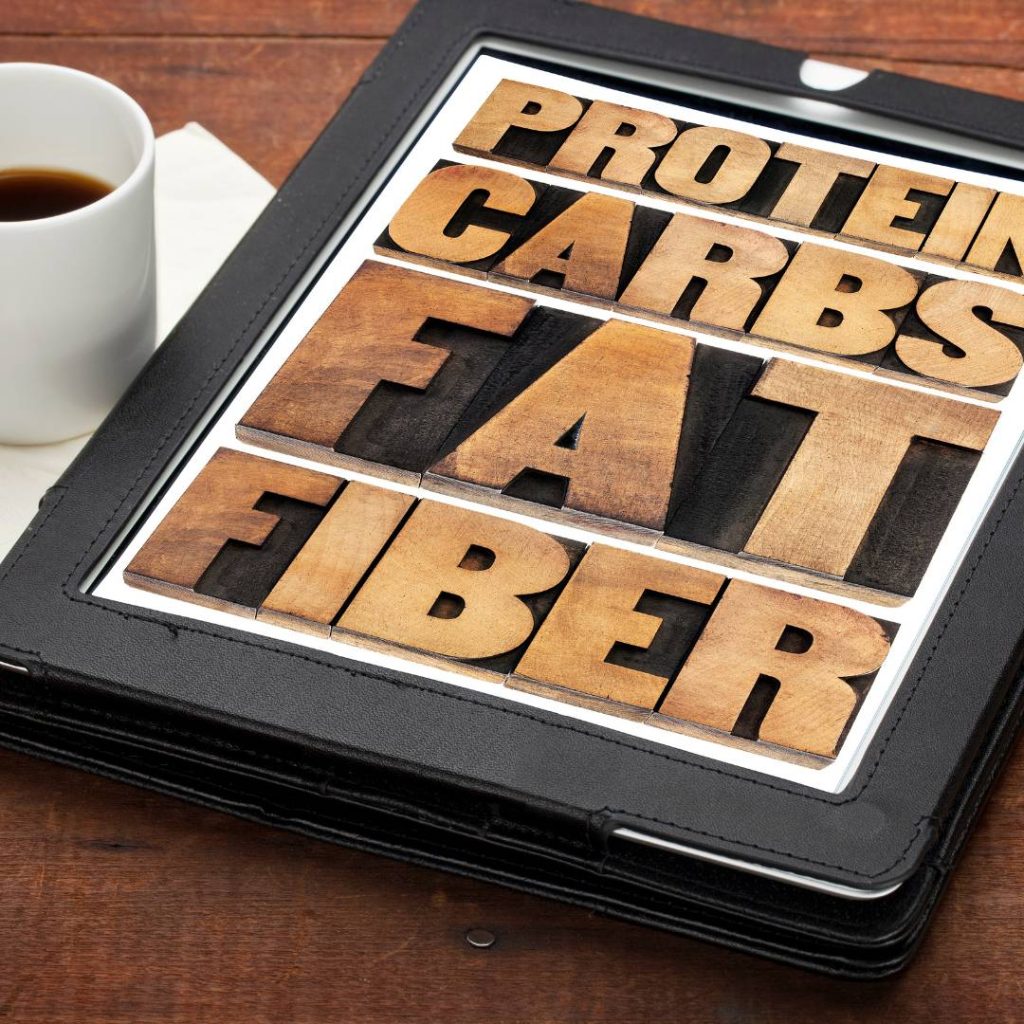
The daily value (DV) is a reference value that shows how much of a nutrient is in one serving of the food compared to the recommended daily intake. The DV is based on a 2,000-calorie diet and is provided for fat, cholesterol, sodium, carbohydrates, fiber, sugar, and protein. The DV percentage listed on the label helps you understand how much of each nutrient is in one serving of the food and how it fits into your daily diet.



Konnichiwa! (Hello!) I'm Pat Tokuyama, a Japanese tofu cookbook author, who travels for music, food, and adventure. If you like Japanese tea, checkout some of the newestorganic japanese tea, matcha bowls and noren and more!
** Curious about the Plant Based Japanese Cooking Club? ** Learn more here!
EPA and USDA
The Environmental Protection Agency (EPA) and the United States Department of Agriculture (USDA) are two government agencies that regulate food labeling. The EPA sets limits on the amount of pesticides and other contaminants that can be present in food, while the USDA regulates the labeling of meat, poultry, and egg products.
In conclusion, understanding food labels is an important step in making informed decisions about what you eat. Paying attention to the serving size, calorie information, and nutrient content can help you manage your calorie intake and make healthier choices. The daily value percentage listed on the label helps you understand how much of each nutrient is in one serving of the food and how it fits into your daily diet.


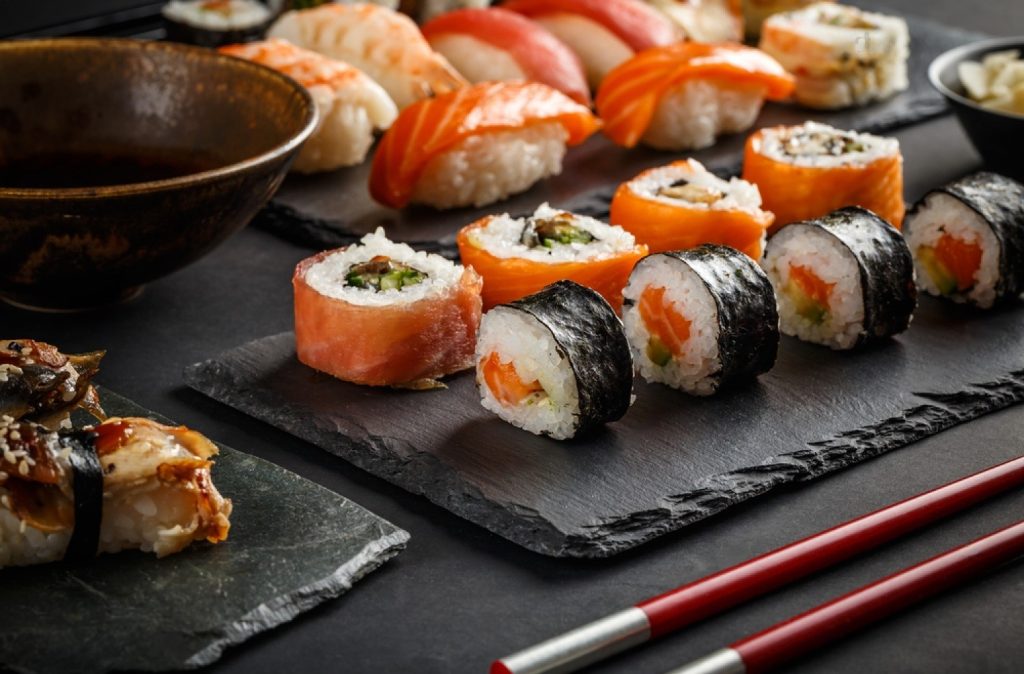

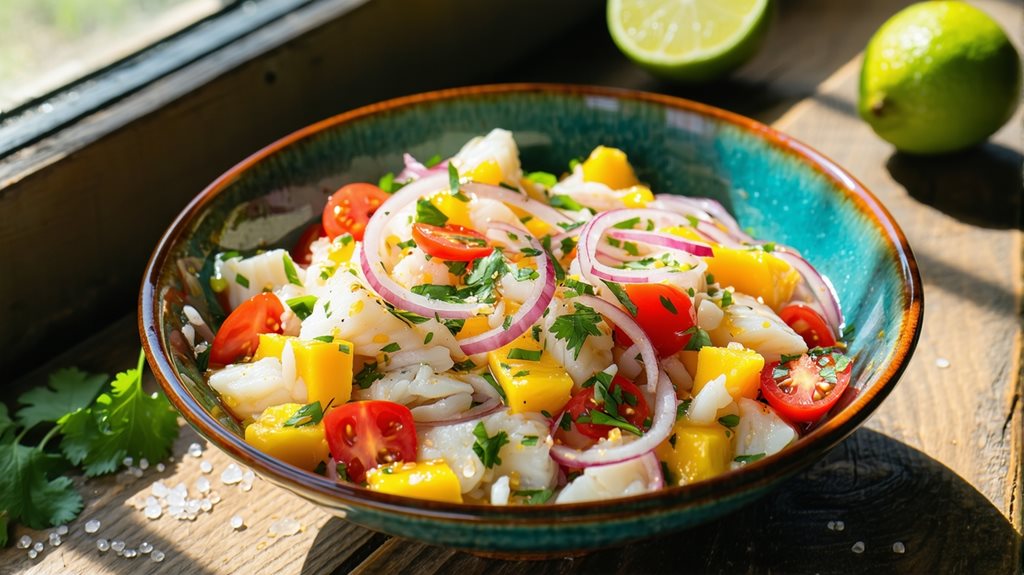
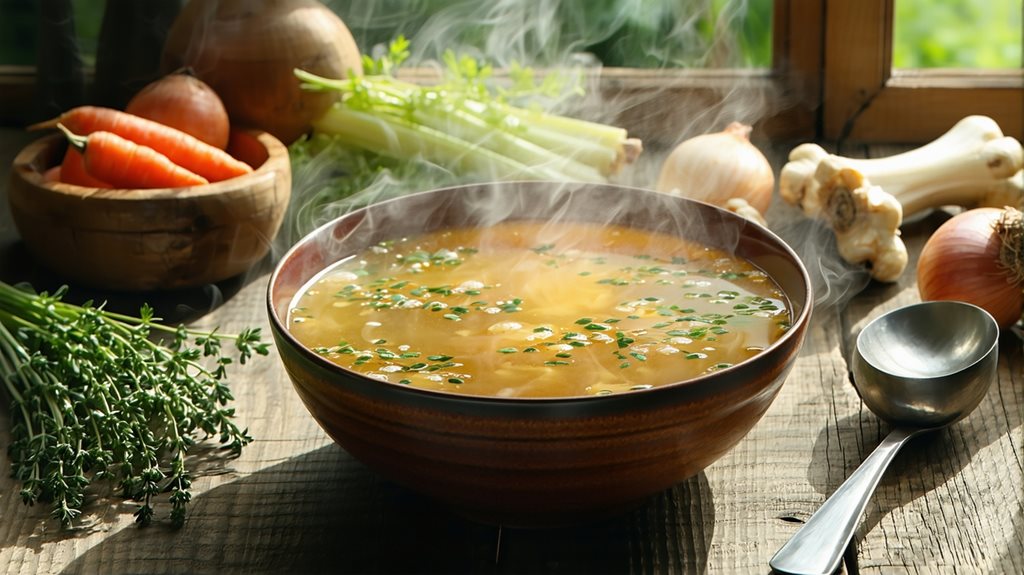
Konnichiwa! (Hello!) I'm Pat Tokuyama, a Japanese tofu cookbook author, who travels for music, food, and adventure. If you like Japanese tea, checkout some of the newestorganic japanese tea, matcha bowls and noren and more!
** Curious about the Plant Based Japanese Cooking Club? ** Learn more here!